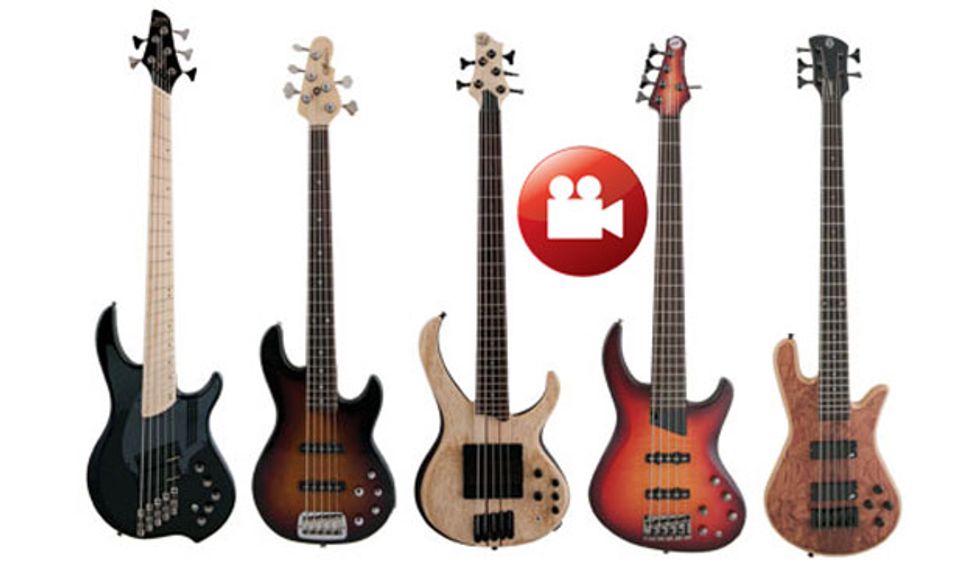
Click on one of the basses to start with that 5-string—Dingwall Combustion NG-2, G&L MJ-5, Ibanez BTB33 Volo, MTD Kingston Saratoga Deluxe, and Spector Legend5 Neck-Thru.
In his On Bass column, touring and session low-ender Victor Brodén recently wrote about the essential instruments a working bassist should possess [“The Wrecking Crew—Basses You Need to Get the Job Done,” January 2015]. A third of this must-have list consisted of 5-string basses. It’s just one example, but there’s no doubt that extended-range instruments have found a permanent and important place in many a bassist’s arsenal.
Leo Fender planted the seed in the mid-’60s with the Bass V (though his creation added a higher 1st string with the 5th string handling low-E duties). The concept of an electric bass with a lower 5th string was popularized in the mid-’70s, exemplified by offerings from Alembic, Michael Tobias, and Carl Thompson. By continuing to develop and refine the design, such luthiers as Ken Smith have helped increase the 5-string’s popularity.
This year, the low-end community was treated to a fresh crop of 5-string machines. Keeping the price between $750 and $1,500, we picked new creations from Ibanez, Dingwall, G&L, Spector, and MTD to measure their musical mettle. Tested under the same conditions, these five instruments all displayed tones, playability, and construction that will suit a variety of players.
We checked out these basses onstage and in a home studio. In the studio we examined build quality, took notes on playability and setup, and critically auditioned each instrument through an Epifani UL 501 head and an Epifani UL3 DIST 112 cabinet. The live evaluations happened in a small club while playing in the house band during a jam night. There, all five basses ran into the UL 501 driving a Bergantino HD212 cab.
Who’s ready to rumble?
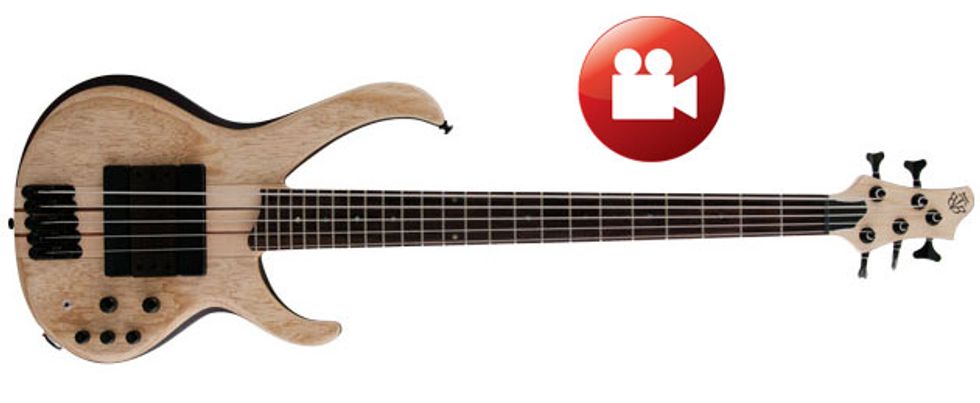
Ibanez BTB33 Volo
In 2014, Ibanez embarked on one of their most experimental projects: the Bass Workshop. Taking a “why not?” approach has breathed new life into their bass designs by transforming some of their popular models into exciting, eye-catching instruments meant to push boundaries. Ibanez introduced the most recent Bass Workshop designs at winter NAMM 2015, and that included the 5-string BTB33. Opting for finesse over burliness, this bass is equipped with a high C string to facilitate fluid solo and chordal playing. Tuned E–A–D–G–C, the 33"-scale BTB33 is nicknamed the “Volo.”Short and Sweet
The organic aesthetic of the BTB33 conveys looks rarely found at its price point. Boasting neck-through construction, the bass has mahogany body wings covered with a heavily grained ash top, a 5-piece neck/center core constructed from maple and bubinga, and a rosewood fretboard adorned with abalone inlays. Rosewood is also used for the finger ramp, which encourages consistent right-hand plucking across all strings by preventing your fingers from digging in too deeply.
jazz-guitar sound.
Ibanez combined forces with Bartolini for the BTB33’s electronics. A pair of long BH1 humbuckers sends the signal to a 3-band Ibanez preamp with switchable 250 Hz, 450 Hz, and 700 Hz midrange settings. The 5-knob arrangement uses two sizes of dials that allow easy differentiation between the preamp and volume/blend section.
Other features include a Neutrik locking jack, Mono-rail bridge, and a Graph Tech nut. Hardware of this quality speaks to the care that Ibanez puts into every detail of the BTB33.
Learning to Fly
Volo is Italian for “flight,” and the compact makeup of the BTB33 certainly invites you to soar across the fretboard. Contributing to speedy shifting is the instrument’s balance that held its position at any angle. The 17mm string spacing at the bridge provides effortless string skipping, though some traditionalists might find it a bit cramped. Creating chord shapes was a breeze, thanks to the narrow neck.
Ratings
Pros:
Slick, compact design with clean tones and cool looks.
Cons:
1st string can be a bit thin. Could be too specialized for all occasions.
Tones:
Playability:
Build/Design:
Value:
Street:
$999
Ibanez BTB33 Volo
ibanez.com
Fans of Matt Garrison might feel compelled to copy his technique on the BTB33, and I was no different. The finger ramp was particularly helpful in keeping my right hand in check, whether I was attempting Garrison’s multi-finger strum style or plucking closed-voice chords.
The BTB33’s sounds resemble its fellow BTB models. With both pickups balanced and a flat EQ, the bass produced a voice with warm mids and a ding in the top end. Soloing the bridge pickup and boosting the mids at 450 Hz formed a barking tone that will satisfy fusion fanatics. The neck pickup on its own had a smoother timbre, but pushing the robust bass EQ helped transform the bass into a boom machine.
Onstage, the size and shape of the BTB33 made for no stress on the back and shoulder. My only real grievance is that the 1st string didn’t cut through the band as well as I had hoped. Boosting the mids helped a bit, but I still ended up spending most of the time on the bottom four strings. I experimented with chords during a jam of the jazz standard “Footprints,” which added some extra support to the guitarist playing the melody. When I played octave patterns around the upper portions of the fretboard during a bass solo, I was able to cop a nice jazz-guitar sound. The overall experience with the BTB33 was definitely rewarding, but with a 5-string bass in hand, I did find myself missing the opportunity to drop those low and deeply satisfying 5th-string bombs on the audience.
The VerdictThe BTB33 Volo is a cool take on Ibanez’s BTB formula. Bassists who are developing their solo voice or experimenting with chords will find this an ideal instrument for exploration. The build and components are impressive, and when you also consider that a Matt Garrison Fodera would set you back several thousands of dollars, the $999 price tag is pretty damn easy to swallow. So if you’re seeking a smaller instrument that’ll help you push your musical voice to the front of the stage, the Volo is worth a test flight.
Watch the Review Demo:
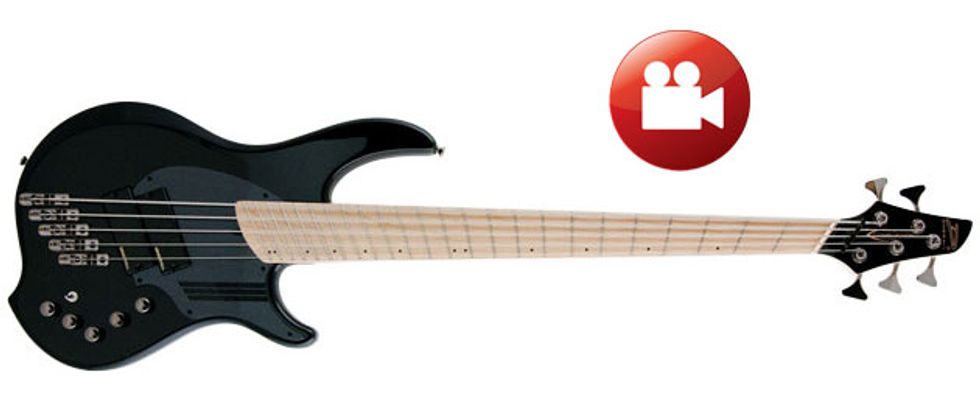
Dingwall Combustion NG-2
Since the 1990s Sheldon Dingwall has forged his own instrument-design path, inspired in part by the Novax fanned-fret system. Periphery bassist Adam “Nolly” Getgood considers Dingwall’s designs the ideal tool for preserving his sonic footprint within his band’s ultra-dense instrumentation, so he and Dingwall collaborated on the NG-2.
Within the Periphery
The NG-2 looks like the bass equivalent of an Italian sports car. A sleek, gloss-black finish protects our review model’s two-piece alder body. The sporty look carries over to the pickguard’s unique shape and carbon-fiber-like patterning. A rigid five-piece maple neck supports a maple fretboard. Fanning across the ’board are 24 banjo frets that deliver a fast feel. Thanks to the fanned-fret arrangement, each string has its own scale length, ranging from 34" for the 1st string to a mighty 37" for the 5th.
through the ensemble.
The NG-2’s engine combines Dingwall and Darkglass electronics. Two Dingwall FD-3N pickups are positioned close together to maximize punch and note definition. Instead of a blend control, Dingwall employs a 4-way rotary selector to engage different pickup combinations. The first setting solos the neck pickup. The second puts both pickups in series for a fat, aggressive sound. The third position configures the pickups in parallel, and the fourth solos the bridge. Despite the pickups’ proximity to each other, they reveal noticeably different character with each turn of the selector switch.
The NG-2 also houses a Darkglass preamp with 3-band EQ. The preamp’s design is the result of a three-way collaboration between Dingwall, Nolly, and Darkglass that pushes the frequencies Nolly likes for growl and girth. The bass frequency is set higher than most bass EQs (at around 70 Hz). Mids are centered at a familiar 500 Hz. There’s no treble attenuator, but a hi-mid control with a 2.8 kHz cutoff. An active/passive switch lets you bypass the preamp.
Ratings
Pros:
Great tones. Inspiring playability. Fantastic 5th string.
Cons:
Hard-to-reach notes high on the fretboard. Limited options for 37"-scale 5th strings.
Tones:
Playability:
Build/Design:
Value:
Street:
$1,500
Dingwall Combustion NG-2
dingwallguitars.com
Canadian Power
The NG-2 feels incredibly comfortable and balanced. The neck is fast and smooth, with a radius that lets the fretting hand maintain a natural position while shifting along the fanned frets. Making the transition to fanned frets is a relatively seamless affair. My only ding (no pun intended) is the somewhat limited access to all the strings when playing at the top of the fretboard.
Tones are deep, punchy, and aggressive. While position 1 doesn’t quite transform the NG-2 into a P-style machine, it conveys similar characteristics. The second position provides a monstrous sound with loads of punch and top end that could make StingRay loyalists do a double take. The fourth setting nails the burpy bridge sound, particularly with a boost in the bass and mid controls.
The NG-2 excels onstage. Using the rotary switch’s second position, the bass’s strong voice cuts through the loudest performers while supporting the band with just the right amount of definition. The preamp is voiced perfectly, whether boosting the bottom for big, blooming lows, or turning up the mids for more assertiveness. Highs are abundant, and the hi-mid control is effective for mellowing them out or adding extra bite.
My fellow musicians lauded the NG-2’s strong voice, especially the sound of the 5th string. Its consistency and power punched through the ensemble, particularly on tunes like the Time’s “Jungle Love.” For gentler jams, cutting hi-mids and soloing the neck pickup produced a deep, articulate tone that was spot-on for songs like “Let’s Stay Together.” Be it slapping or 16th-note bass lines, the NG-2 was responsive and a joy to play overall.
The Verdict
The NG-2’s playability, tone, and 5th-string power outperform some basses that cost two or three times as much. It’s more than just a rock bass—while its timbres may not cater to all old-school preferences, it can handle almost every musical situation with authority. If you haven’t yet found your ideal 5-string, I recommend taking the NG-2 for a test drive.
Watch the Review Demo:
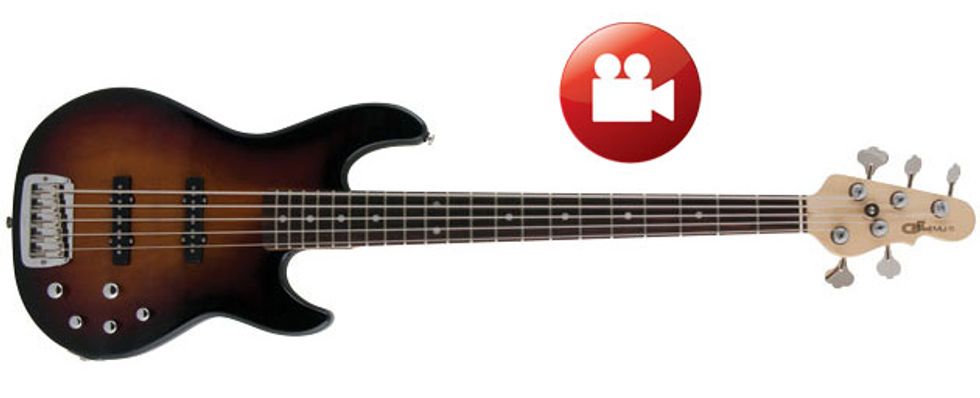
G&L MJ-5
After making marks with his namesake company and Music Man, Leo Fender established G&L with partner George Fullerton (G&L stands for “George and Leo.”) From 1979 till Leo’s death in 1991, G&L improved on past designs and innovated new ones. This year, the Fullerton, California, company released the new MJ-5 5-string bass, which combines G&L’s M-series designs with Jazz-style humbuckers.
Dressed for Success
The MJ-5’s body is alder, and our tester was decked out in a 3-tone sunburst finish. Six bolts support a quartersawn maple neck topped with a rosewood fretboard. The medium-jumbo frets are uniformly dressed with the aid of a Plek machine. The neck’s satin finish is nice and smooth.
The MJ-5 delivers modern yet classic tones via a pair of G&L bi-coil alnico 5 pickups. They may look like typical J-style pickups, but they’re actually split-coil hum-canceling pickups. G&L’s 18V “MJ-spec” preamp processes their sounds. Unlike the switches and knobs found on the company’s L series instruments, this system strips things down to a 3-knob, 3-band configuration. The EQ points are centered at 40 Hz for the bass, 600 Hz for the mids, and 8 kHz for the treble.
Rounding out the appointments are two company signatures: a heavy-duty Saddle Lock bridge, and the distinctive G&L headstock, here with Ultra-Lite tuners. Like a fresh engine in a Cadillac, the MJ-5 looks clean, sophisticated, and totally classic.
Ratings
Pros:
Flexible, familiar sounds. Cozy neck. Classic looks.
Cons:
Hum-canceling pickups might not please vintage connoisseurs.
Tones:
Playability:
Build/Design:
Value:
Street:
$1,462
G&L MJ-5
glguitars.com
Traces of Familiar Faces
The MJ-5’s 12" radius and 1 3/4" nut permit hindrance-free movement. The bass maintains a comfortable playing orientation, but those who like to wear their instruments positioned at a high angle may find the MJ-5 trying to settle back to a lower one.
With the pickups blended, I dialed in a great slap sound with a bit bass and treble boost. The neck pickup alone delivers a familiar fatness that J-style aficionados will appreciate. Meanwhile, Jaco disciples should get the vibe they seek by soloing the bridge with some bass and mid boost. Most important, you can obtain clear, articulate sounds with the preamp set flat. The pickups don’t precisely replicate vintage Fender sounds, but they get very close, and any differences are a small price to pay for eliminating 60-cycle hum.
The MJ-5’s qualities projected nicely onstage, and its familiar tones fit right into the mix. The mid control is attractively voiced—not too honky or harsh—and a boost here helped the MJ-5 cut through the band.
The 5th string produces satisfying lows. Chromatic fretboard walks sound clear, with each pitch easily distinguished. Like any great J-style bass, the MJ-5 performed well in a wide range of styles, from R&B tunes like “Respect” to zydeco jams to a spontaneous rendition of Van Halen’s “Panama.”
The Verdict
G&L’s MJ-5 has the essentials most bassists desire: comfort, flexibility, and familiarity. Onstage or in the studio, the hum-cancelling electronics sound pleasing and are easy to operate. It should be mentioned that this is the only U.S.-built bass in this 5-string roundup, and the instrument has plenty to offer for a hair under $1,500. Whether you’re a 4-string player ready expand to 5-string, or simply seeking a new road-ready workhorse, the MJ-5 should definitely be on your audition list.
Watch the Review Demo:
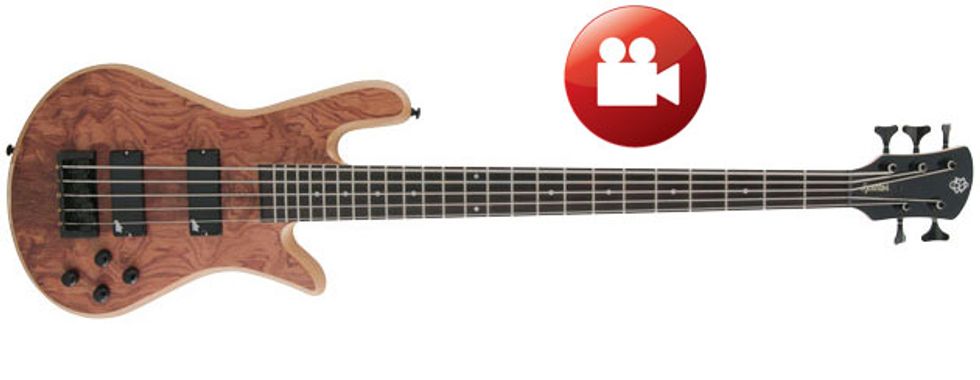
Spector Legend5 Neck-Thru
Stuart Spector has been crafting high-end basses since the ’70s. He diversified his product line in the ’80s with an affordable Korean-made series, whose latest offering is the Legend5 Neck-Thru, a slick 5-string offering loaded with Aguilar electronics.
Ghost in the Shell
The Legend5 Neck-Thru’s boutique looks belie its $1,400 price tag. The maple body wings of our tester were topped with a bubinga veneer. Players who prefer natural looks will most likely dig the attractive figuring and satiny feel. (The Legend Neck-Thru is also offered in a faded blue-gloss finish over a figured-maple top.)
and speed in mind.
Between the wings is a 3-piece maple neck stiffened by graphite rods and topped with a rosewood fretboard. While Spector has historically relied on his own and EMG for electronics, he chose to equip the Legend5 Neck-Thru with DCB humbuckers and an OBP-2 preamp from Aguilar.
Playing the instrument immediately reveals the quality of Spector’s craftsmanship. Whether playing seated or strapped, the body balances almost perfectly. Players accustomed to a traditional 34"-scale length may find the 35"-scale odd at first, but the extra inch greatly benefits the 5th string’s response.
Ratings
Pros:
Versatility. Attractive natural looks. Solid 5th string.
Cons:
The scale length may take some getting used to.
Tones:
Playability:
Build/Design:
Value:
Street:
$1,399
Spector Legend5 Neck-Thru
spectorbass.com
Shifting your fretting hand into higher positions, you feel the neck gradually taper to a flatter profile. Despite a slight bump in the neck around the 6th fret, the shape invites quick position shifts with minimum effort. With its 1.75" nut width and .66" string spacing at the bridge, the Legend Neck-Thru was clearly designed with hand comfort and speed in mind. I only wish the cutaways were even deeper so I could better reach the top of the fretboard.
Brutal Legend
Sonically, the Spector is a growler. The combination of Aguilar electronics and the long scale deliver quick attack with strong articulation. The lower notes of the 5th string speak with punch and definition, and the first five frets deliver impressive clarity. Engaging both pickups produces a sound that reminds me of a bass voice in an a cappella ensemble. Soloing the neck pickup and boosting the bass EQ creates a buh-like tone that bassists have come to know so well. (If you leave your trusty P at home, this configuration gets very close to replicating that sound.) Finally, the soloed bridge pickup produces a mid-heavy snarl that lent my bass lines presence and power.
The Spector works great live. I needed a little time to adjust to the long scale, but occasional glances at my left hand eventually established muscle memory. The preamp solved any sonic issues, from boosting the bass EQ for increased fundamentals, to pushing the treble to cut through the band. The switch from bridge-pickup aggression for tunes like “Uptown Funk” to neck-pickup punch for Motown-influenced jams was seamless. And after the set, I felt no fatigue due to the instrument’s long scale.
The Verdict
The latest addition to the Legend series offers neck-thru construction for the cash-conscious bassist while adding a new voice to the Spector family. I found the Legend5 Neck-Thru to be an attractive 5-string axe that’s highly adaptable to many musical situations.
Watch the Review Demo:
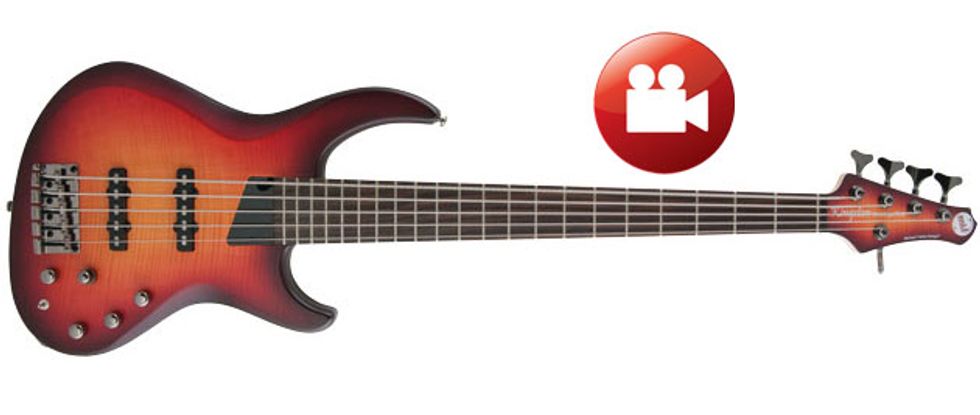
MTD Kingston Saratoga Deluxe
Michael Tobias’ handcrafted offerings are the instruments of choice for a number of notable players, while his overseas-built Kingston series provides bassists a taste of his innovations at a more comfortable price point. Bringing hints of MTD’s classic characteristics, the Kingston Saratoga Deluxe—the luthier’s most recent offering—spruces up the style and sound of the original Kingston Saratoga, yet still comes to the party at under a grand.
Kingly Build
The Kingston Saratoga Deluxe’s contoured J-style body is constructed of basswood and capped with a nice piece of flamed maple. The deep cherry burst finish of our test bass adds fire to the flamed top and also colors the matching headstock.
The maple neck has an asymmetrical neck profile—a hallmark of MTD design since the late ’70s—so it was no surprise to see (and feel) the comfy, fast shape on the Saratoga Deluxe. A rosewood fretboard fronted the neck of our tester, but those seeking brighter sounds can opt for a maple fretboard or fretless ebony fingerboard.
Another MTD staple is the Buzz Feiten tuning system, intended to provide better intonation and tuning stability. MTD also outfits the Saratoga Deluxe with a quick-release bridge for on-the-fly string changes and optimum transference of string vibrations.
A pair of passive J-style hum-canceling pickups feed the signal to a 3-band, 9V preamp. A switch lets you choose between active or passive modes, and also offers a way to keep playing if the battery dies unexpectedly. In passive mode, a tone knob stacked within the volume dial provides subtle shaping control.
The MTD Touch
Strapped up, the Kingston Saratoga Deluxe was easy on the shoulder and back, and it rested at a comfortable playing angle with zero neck dive. The 34" scale and asymmetrical neck make for a great combo by offering smooth transitions to all areas of the fretboard. Unplugged, the notes of the open 5th string and its first four frets had plenty of low end, but they did leave a little to be desired in terms of definition.
Ratings
Pros:
A comfortable, modern-sounding bass that’ll give players a satisfying sample of MTD’s upper-echelon offerings.
Cons:
Somewhat underwhelming 5th string. May not satisfy J-style purists.
Tones:
Playability:
Build/Design:
Value:
Street:
$999
Company
mtdkingston.com
After a quick re-soldering of one of the mid-control wires that had a loose connection, the Kingston Saratoga Deluxe was ready to display its tones. With everything set flat, the instrument hinted at MTD timbres—lots of glass and plenty of ass. The single-coil pickups convey more of a modern vibe than a classic-J voice, and the 3-band preamp is geared for contemporary tones. This axe’s specialties are glassy highs, present mids, and deep lows. Though the Kingston Saratoga Deluxe’s electronics package could be initially perceived as a slapper’s delight, I was able to dial in barking, bridge-pickup tones and solid dub-style thump.
The characteristics displayed at home transferred to the stage, where the bass produced excellent scooped, supportive sounds that were well suited to funk and R&B. The bass delivered punchy, zing-infused thumping and popping on “Never Too Much” by Luther Vandross and Sly and the Family Stone’s “Thank You (Falettinme Be Mice Elf Again).”
The Saratoga Deluxe’s bridge-pickup tones fit best within an ensemble that consisted of a keyboardist, guitarist, and drummer. The sound from blending both pickups equally with the EQ flat tended to get a little lost in the mix, but a simple boost in the mids and lows with this configuration maintained the Kingston Saratoga Deluxe’s presence in the band. And while I would have liked a bit more clarity from the 5th string’s lower notes, it did provide a big low-end that filled the room nicely.
The Verdict
The Kingston Saratoga Deluxe takes samples from MTD’s handcrafted instruments and works them into a budget-friendly package. Its playability is pleasing, and its sounds cover a variety of styles from modern gospel to metal. If you’re seeking a taste of Michael Tobias’s designs, yet want to save a whole lot of coin while doing so, this bass is worth a good look.
Watch the Review Demo:







![Rig Rundown: AFI [2025]](https://www.premierguitar.com/media-library/youtube.jpg?id=62064741&width=1245&height=700&quality=70&coordinates=0%2C0%2C0%2C0)












 Shop Scott's Rig
Shop Scott's Rig
![Rig Rundown: Russian Circles’ Mike Sullivan [2025]](https://www.premierguitar.com/media-library/youtube.jpg?id=62303631&width=1245&height=700&quality=70&coordinates=0%2C0%2C0%2C0)














































